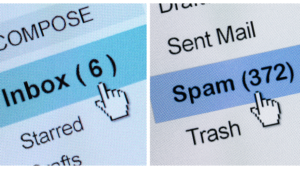Spam filters have gotten really complex. They go through each line of your content looking for sketchy links, “spammy” phrases, and exaggerated elements. Fortunately, you can avoid getting flagged as spam through some of the tips below!

What are spam filters?
Spam filters are programs that are used to detect unsolicited, irrelevant, and potentially harmful emails. They prevent these kinds of emails from reaching inboxes and throw them into the spam folder.
Because spam filters have gotten so sophisticated, sometimes your genuine emails can get labeled as spam. In fact, 21% of emails sent by legitimate email marketers end up in the junk folders!
If you aren’t careful, your email ads could get flagged and never reach your recipients. Try and keep these tips in mind next time you start your email marketing campaign.
Be Careful of your Subject Line
The subject line is the first thing your recipient will see. Avoid phrases like “this is urgent/exclusive offer/avail NOW!” (phrases you might hear on TV shopping channels) because those phrases are open invitations to spam folders.
Your job is to at least get them to open your email. A relevant subject line that corresponds to the content of your email should do the trick.
Obviously, don’t leave your subject line blank.
Don’t overdo it!
In general, just don’t be an annoying attention-seeker in your emails.
- Don’t over-optimize. Use your keywords sparingly and realistically. Don’t add too many links back to your landing page.
- Don’t over decorate. No crazy font sizes or font colors, excessive underlining, or highlighting.
- Don’t send too many emails! 57% of people say that receiving too many emails from a sender makes them mark them as spam, even if they signed up to receive emails from that business.
Avoid using general business emails
Emails that start with newsletter@ / noreply@ / marketing@ could trigger spam filters, but also provide a bad user experience for your readers. Most customers don’t want to read ads from an email they think is automated!
For instance, try using a real person’s business email for your email marketing campaigns. If you really have to use a general email, be sure to use that consistently through the entirety of your email campaign.
Remove inactive subscribers
If you find that most of the people on your mail list aren’t responding to your emails, you probably should try a different approach.
Before you start removing subscribers, try re-engagement campaigns to recapture their attention. Send “we’ve missed you” emails or “are you still interested in?” And if they still aren’t responding, then stop sending them emails or ask them to unsubscribe! Focus your attention on those already interested and finding more who will find value in what you sell.
Additionally, you should also include an easy-to-find “unsubscribe” button at the bottom of every e-mail. Not only do they trigger spam filters, but users who can’t find an unsubscribe button will also just flag you as spam.
Conclusion
Finally, you should remain relevant, purposeful, and genuine in your email marketing campaigns, just like you would in any marketing strategy! If you’re investing time and money onto email campaigns, make sure it’s useful for your audience above all. In the long run, ad gimmicks and clickbaits are scams, and you won’t find the conversion you’re looking for.


